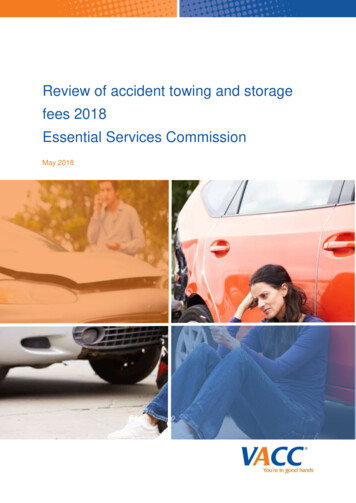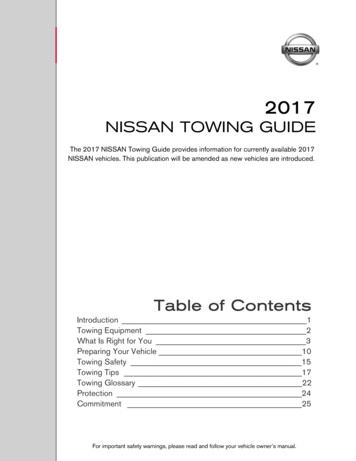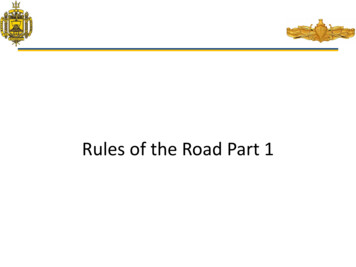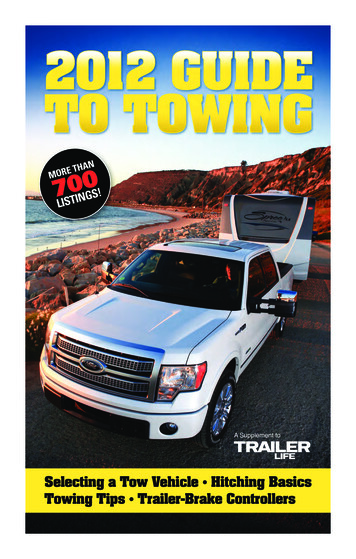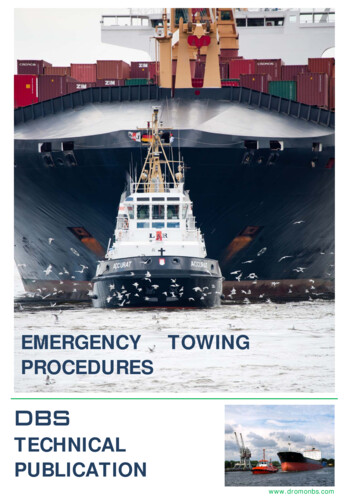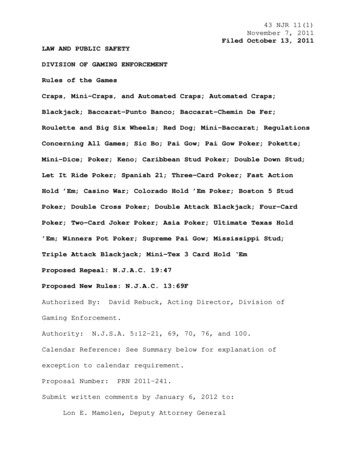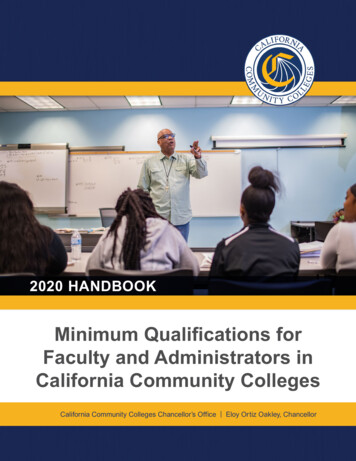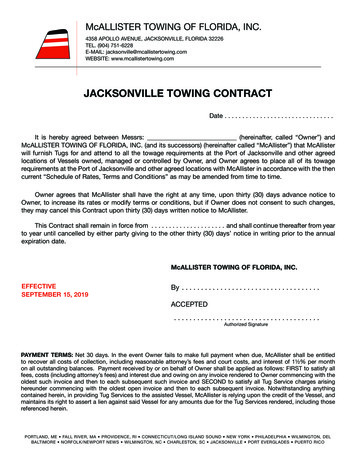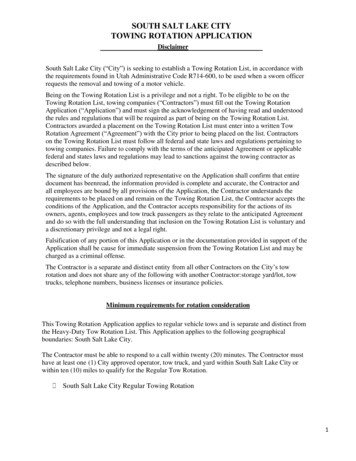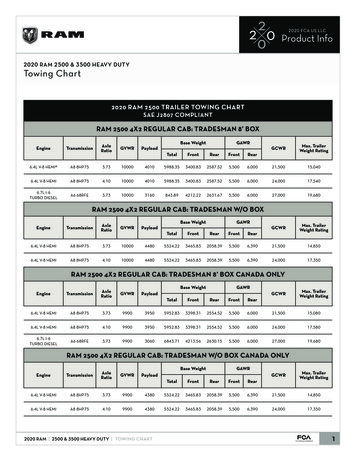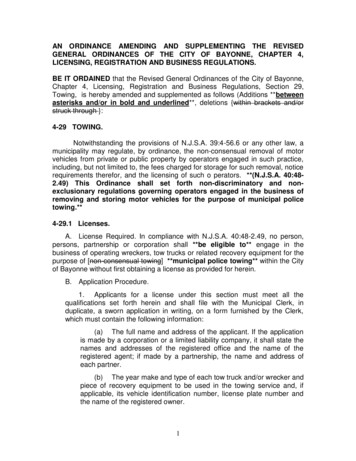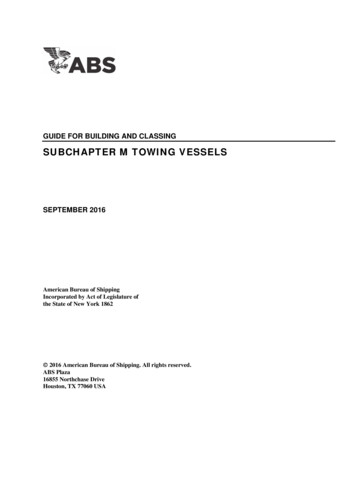
Transcription
Guide for Building and Classing Subchapter M Towing VesselsGUIDE FOR BUILDING AND CLASSINGSUBCHAPTER M TOWING VESSELSSEPTEMBER 2016American Bureau of ShippingIncorporated by Act of Legislature ofthe State of New York 1862 2016 American Bureau of Shipping. All rights reserved.ABS Plaza16855 Northchase DriveHouston, TX 77060 USA
ForewordForewordThis Guide for Building and Classing Subchapter M Towing Vessels has been developed to clarify therequirements for classing existing and new towing vessels in service on major rivers and connectingintracoastal waterways, which are required to comply with 46 CFR Subchapter M, Inspection of TowingVessels, Final Rule (Sub M), which was published in the U.S. Federal Register on June 20, 2016.The Guide provides supplemental and alternative requirements to the ABS Rules for Building and ClassingSteel Vessels for Service on Rivers and Intracoastal Waterways (ABS River Rules) based on a comparisonto Sub M. Requirements for equipment and arrangements regarding lifesaving, fire protection, machinery,piping, electrical, structure and stability are addressed.A vessel complying with the requirements contained in the River Rules and this Guide will comply withthe design, construction, and outfitting requirements of Sub M and be eligible for Classification with ABS.This Guide becomes effective on the first day of the month of publication.Users are advised to check periodically on the ABS website www.eagle.org to verify that this version ofthis Guide is the most current.We welcome your feedback. Comments or suggestions can be sent electronically by email to rsd@eagle.org.iiABS GUIDE FOR BUILDING AND CLASSING SUBCHAPTER M TOWING VESSELS . 2016
Table of ContentsGUIDE FOR BUILDING AND CLASSINGSUBCHAPTER M TOWING VESSELSCONTENTSSECTION 1General . 11Classification Notations. 13Scope . 15Application . 17Definitions . 29SECTION 2SECTION 37.1Towing Vessel . 27.3Existing Towing Vessel. 27.5New Towing Vessel . 27.7Excepted Vessel . 27.9Length . 37.11Other Definitions . 3Plans and/or Data . 3Requirements . 51Supplemental Requirements. 53Alternative Requirements. 21TABLE 146 CFR Part 141 – Lifesaving – SupplementalRequirements . 6TABLE 246 CFR Part 142 – Fire Protection – SupplementalRequirements . 8TABLE 346 CFR Part 143 – Machinery and Electrical Systems andEquipment – Supplemental Requirements . 11TABLE 446 CFR Part 144 – Construction and Arrangement –Supplemental Requirements. 18TABLE 5Alternative Requirements. 21Survey Requirements for Additional Systems and Services . 221Towing Vessel (Sub M, River Service) Notation . 22ABS GUIDE FOR BUILDING AND CLASSING SUBCHAPTER M TOWING VESSELS . 2016iii
This Page Intentionally Left Blank
Section 1: General1SECTION1GeneralClassification NotationsVessels which have been built to the satisfaction of the ABS Surveyors to the requirements contained inthe ABS Rules for Building and Classing Steel Vessels for Service on Rivers and Intracoastal Waterways(ABS River Rules) and this Guide, where approved by the Committee, are to be classed and distinguishedin the Record by the symbols À A1 for vessels built under ABS attendance, or A1 for existing vesselsentering class, followed by the notation Towing Vessel (Sub M, River Service).3ScopeThe following table describes the scope of this document by providing a cross-reference between the Partsof Sub M and Sections of this Guide.Sub M Part No.Note:5Sub M Part TitleGuide SectionPart 136CertificationSee NotePart 137Vessel Compliance3/1Part 138Towing Safety Management System (TSMS)See NotePart 139Third-Party OrganizationsSee NotePart 140Operations3/1Part 141Lifesaving2/1, Table 1; 3/1Part 142Fire Protection2/1, Table 2; 3/1Part 143Machinery and Electrical Systems and Equipment2/1, Table 3; 2/3, Table 5; 3/1Part 144Construction and Arrangement2/1, Table 4; 3/1Refer directly to applicable Parts of Sub M.ApplicationThis Guide is applicable to towing vessels, as defined in 1/7.1, in service on major rivers and connectingintracoastal waterways. The listed routes permitted by Sub M are as indicated in 46 CFR 136.230. Therequirements laid forth in this Guide are clarifications to the ABS River Rules for vessels intended forservice in bodies of comparatively smooth water.Classification of any vessel subject to Sub M that is not exclusively in service on rivers and intracoastalwaterways is subject to the ABS Rules for Building and Classing Steel Vessels Under 90 Meters (295 feet)in Length (ABS Under 90 Meter Rules). This Guide is not intended to apply to vessels in service on theGreat Lakes of North America, coastwise operation, or on any ocean regardless of US Gross Tonnage.ABS GUIDE FOR BUILDING AND CLASSING SUBCHAPTER M TOWING VESSELS . 20161
Section1General7Definitions7.1Towing VesselFor the purposes of this document, a Towing Vessel is defined by 46 CFR 136.110, with applicability per46 CFR 136.105.Per 46 CFR 136.110, a Towing Vessel means a commercial vessel engaged in or intending to engage in theservice of pulling, pushing, or hauling alongside, or any combination of pulling, pushing, or haulingalongside. Per 46 CFR 136.105, Sub M is applicable to all U.S.-flag towing vessels as defined in 46 CFR136.110 engaged in pushing, pulling, or hauling alongside, except:i)A vessel less than 7.92 meters (26 feet) in length measured from end to end over deck (excluding thesheer), unless that vessel is pushing, pulling, or hauling a barge that is carrying oil or hazardousmaterial in bulk;ii)A vessel engaged in one or more of the following:a)Assistance towing as defined in 46 CFR 136.110;b)Towing recreational vehicles for salvage; orc)Transporting or assisting the navigation of recreational vessels within and betweenmarinas and marina facilities, within a limited geographic area, as determined by the localCaptain of the Port (COTP);iii)A workboat operating exclusively within a worksite and performing intermittent towing within theworksite;iv)A seagoing towing vessel of 300 gross tons or more subject to the provisions of 46 CFRSubchapter I;v)A vessel inspected under other subchapters of 46 CFR that may perform occasional towing;vi)A public vessel as defined in 46 U.S.C. 2101;vii)A vessel which has surrendered its Certificate of Inspection (COI) and is laid up, dismantled, orotherwise out of service; andviii)A propulsion unit used for the purpose of propelling or controlling the direction of a barge where theunit is controlled from the barge, is not normally manned, and is not utilized as an independent vessel.7.3Existing Towing VesselPer 46 CFR 136.110, an Existing Towing Vessel means a towing vessel, subject to inspection under Sub M,which is not a new towing vessel, as defined in this section.7.5New Towing VesselPer 46 CFR 136.110, a New Towing Vessel means a towing vessel, subject to inspection under Sub M, that:7.7i)Had its keel laid or was at a similar stage of construction on or after July 20, 2017; orii)Underwent a major conversion that was initiated on or after July 20, 2017.Excepted VesselPer 46 CFR 136.110, an Excepted Vessel means a towing vessel that is subject to Sub M but is exceptedfrom certain provisions contained within this subchapter. An excepted vessel is:i)2Used solely:a)Within a limited geographic area, as defined in 46 CFR 136.110;b)For harbor-assist, as defined in 46 CFR 136.110;c)For response to an emergency or a pollution event; orABS GUIDE FOR BUILDING AND CLASSING SUBCHAPTER M TOWING VESSELS . 2016
Section1ii)GeneralExcepted by the cognizant OCMI for purposes of some or all of the requirements in 46 CFR 142.315through 142.330, 143.235, 143.265, and subpart C of part 143 of Sub M, based on consideration ofthose requirements and on reasons submitted by the vessel owner or managing operator as to whythe vessel does not need to meet these requirements for the safe operation of the vessel.7.9LengthPer 46 CFR 136.110, Length means the horizontal distance measured from end to end over the deck,excluding the sheer. Fittings and attachments are not included in the length measurement.7.11Other DefinitionsA full list of definitions specific to Sub M can be found in 46 CFR 136.110. Definitions specific to theABS Rules related to this Guide can be found in the beginning of each part within the ABS River Rules.9Plans and/or DataThe following plans and/or data are to be submitted: General arrangement (including tank arrangement, handrails, and bulwarks) Midship section and scantling plans Bottom, deck, and side shell plating Transverse and longitudinal bulkheads Deckhouses Water-tight/weather-tight closure devices (including manholes, hatches, doors, etc.) Stability (lines and offsets, curves of form, cross curves of stability, etc.) (as applicable) Rudder and rudder stock (including vessel speed) Main engines, propulsion gears, and clutch systems (manufacturer make, model, and rating information,reduction ratio, etc.) Propulsion shafting and control system Propellers over 60 inches diameter Pressure vessels and heat exchangers Machinery arrangement and equipment list (including electrical) Shell penetrations (if not otherwise covered, including seachests, scuppers, sanitary overboards, externalcooler installations, etc.) Steering gear piping, arrangements, and control system Bilge/ballast piping Fuel/lube oil piping Flammable/combustible liquid piping (if not otherwise covered) Fire main piping (including calculations) Cooling water Compressed air Vents, sounds, and overflows Ventilation Engine exhaustABS GUIDE FOR BUILDING AND CLASSING SUBCHAPTER M TOWING VESSELS . 20163
Section1General Group I (high pressure) piping (if not otherwise covered) such as hydraulics Fire and safety plan (fire protection equipment and lifesaving appliances) Fixed fire-extinguishing (including calculations) (as applicable) Fire and smoke detection Towing arrangements AC/DC electrical one line and load analysis Remote shutdowns Alarms and monitoring Main switchboard wiring and details Shipboard lighting and power Internal communications (including general alarms or public address, pilothouse alerter system, asapplicable) Navigation lightingAdditional plans and/or data may be required for additional Class Notations.4ABS GUIDE FOR BUILDING AND CLASSING SUBCHAPTER M TOWING VESSELS . 2016
Section 2: RequirementsSECTION12RequirementsSupplemental RequirementsIn general, vessels are to comply with the requirements contained in the ABS River Rules and this Guide toreceive the notations listed in Subsection 1/1.Various requirements from Sub M are considered to be outside the scope of, and therefore supplemental to,the ABS River Rules. These supplemental requirements are summarized in Section 2, Table 1 throughSection 2, Table 4 for Lifesaving, Fire Protection, Machinery and Electrical Systems and Equipment, andConstruction and Arrangement, respectively.The “Existing Vessel” and “New Vessel” columns indicate whether such vessels, as defined by 1/7.3 and1/7.5, respectively, are to comply with specific provisions.The provisions listed in the “Supplemental Requirements” column are not exhaustive; each original ruleand regulation is applicable as written in its original form, with conditions, summaries and clarificationslisted herein for guidance.Certain sections of Sub M that are considered administrative, operational, or less stringent than correspondingABS River Rules have not been listed.ABS GUIDE FOR BUILDING AND CLASSING SUBCHAPTER M TOWING VESSELS . 20165
Section6TABLE 146 CFR Part 141 – LifesavingSurvival CraftExistingVesselNewVesselYesYesSub M CFR141.305; 141.310;141.315; 141.320;141.325; 141.330;Table 141.305ABS RiverRulesN/ASupplemental Requirementsa)b)c)d)ABS GUIDE FOR BUILDING AND CLASSING SUBCHAPTER M TOWING VESSELS . h towing vessel operating in warm water is to carry sufficient rigid buoyant apparatus(approval series 160.010) to accommodate the total number of individuals onboard.Each towing vessel operating in cold water is to carry sufficient inflatable buoyantapparatus (approval series 160.010) to accommodate the total number of individuals onboard.Survival craft are to meet the requirements of 141.305(b)(1) and (5) for accessibility andmarking, respectively.The following approved survival craft may be substituted for survival craft required byTable 141.305:1) An inflatable liferaft approved under approval series 160.051 or 160.151, may besubstituted for an inflatable buoyant apparatus or rigid buoyant apparatus.2) An inflatable buoyant apparatus approved under approval series 160.010 may besubstituted for a rigid buoyant apparatus.3) A life float approved under approval series 160.027 may be substituted for a rigidbuoyant apparatus.Each towing vessel is to carry at least one appropriately-sized lifejacket, approved underapproval series 160.002, 160.005, 160.055, 160.155, or 160.176, for each person on board.For towing vessels with berthing aboard, a sufficient number of additional lifejackets are tobe carried so that a lifejacket is immediately available for persons at each normally mannedwatch station.Where alternative means are used to meet the requirements of this section, as permitted by141.225, there is to be at least one lifejacket for each person onboard.Lifejackets are to be readily accessible.If the towing vessel carries inflatable lifejackets, they are to be of similar design to eachother and have the same mode of operation.Each lifejacket is to be marked according to 141.340(f).Lifejackets are to meet the requirements of 141.340(g) for attachments and fittings.Stowage positions for lifejackets stowed in a berthing space or stateroom and all lifejacketcontainers are to be marked in block capital letters and numbers with the minimumquantity, identity, and, if sizes other than adult or universal sizes are used on the vessel, thesize of the lifejackets stowed inside the container. The equipment may be identified inwords or with the appropriate symbol from IMO Resolution A.760(18).RequirementsSubject2Supplemental Requirements
SectionSupplemental Sub M CFR141.360ABS RiverRulesN/ASupplemental Requirementsa)b)c)Visual Distress SignalsYesYes141.370; 141.375;Table 141.370N/Aa)b)c)d)e)A towing vessel is to carry lifebuoys as follows:1) A towing vessel less than 7.92 m (26 ft) in length is to carry a minimum of onelifebuoy of not less than 510 mm (20 in.) in diameter.2) A towing vessel of at least 7.92 m (26 ft), but less than 24.08 m (79 ft), in length is tocarry a minimum of two lifebuoys located on opposite sides of the vessel wherepersonnel are normally present. Lifebuoys are to be at least 610 mm (24 in.) indiameter.3) A towing vessel 24.08 m (79 ft) or more in length is to carry four lifebuoys, with onelifebuoy located on each side of the operating station. Lifebuoys are to be at least 610mm (24 in.) in diameter.Each lifebuoy on a towing vessel is to meet the approval, securing and markingrequirements of 141.360(b)(1)-(4).Lifebuoys are to meet the requirements of 141.360(c) for attachments and fittings.A towing vessel is to carry a combination of day and night visual distress signals indicatedin Table 141.370 for specified areas where the vessel operates.Hand-held red flare distress signals, approved under approval series 160.021 or 160.121,and hand-held rocket-propelled parachute red flares, approved under approval series160.036 or 160.136, are acceptable as both day and night signals.Floating orange smoke signals, approved under approval series 160.022, 160.122, or160.157, and hand-held orange smoke distress signals, approved under approval series160.037, are only acceptable as day signals.A vessel operating in a limited geographic area on a short run limited to approximately 30minutes away from the dock is not required to carry visual distress signals under thissection.Each pyrotechnic distress signal carried to meet this section is to be stowed according to141.375(e).RequirementsSubject2ABS GUIDE FOR BUILDING AND CLASSING SUBCHAPTER M TOWING VESSELS . 2016TABLE 1 (continued)46 CFR Part 141 – Lifesaving7
Section8TABLE 246 CFR Part 142 – Fire ProtectionApproved EquipmentExistingVesselNewVesselYesYesSub M CFR142.215ABS RiverRules4-4-1/19;4-4-1/Table 1Supplemental Requirementsa)b)c)ABS GUIDE FOR BUILDING AND CLASSING SUBCHAPTER M TOWING VESSELS . 2016Storage of Flammable orCombustible ProductsYesYes142.2254-4-1/19.1;4-4-1/Table 2;4-5-3/ 11.5a)b)All hand-portable fire extinguishers, semi-portable fire-extinguishing systems, and fixedfire-extinguishing systems required by this part are to be USCG approved.New installations of fire-extinguishing and fire-detection equipment of a type not required,or in excess of that required by this part, may be permitted if USCG approved, or ifaccepted by the local OCMI or ABS.Existing equipment and installations not meeting the applicable requirements of this partmay be continued in service so long as they are in good condition and accepted by the localOCMI or ABS.If a dedicated storage cabinet is provided it is to be secured to the vessel so that it does notmove and is to be either:1) A flammable liquid storage cabinet that satisfies UL 1275; or2) A flammable liquid storage cabinet that satisfies FM Approvals Standard 6050; or3) Another suitable steel container that provides an equivalent level of protection.A B-II portable fire extinguisher is to be located near the storage room or cabinet. This is inaddition to the portable fire extinguishers required by Tables 142.230(d)(1) and142.230(d)(2).Fire AxeYesYes142.227N/AEach towing vessel is to be equipped with at least one fire axe that is readily accessible foruse from the exterior of the vessel.Hand-Portable FireExtinguishing EquipmentYesYes142.230;Table Ref 142.215;142.225(d))4-4-1/15;4-4-1/Tables 1 & 2Depending on the length, tonnage, and existence of a fixed fire-extinguishing system in themachinery space, a higher quantity of approved hand-portable extinguishers may berequired per 142.230 than per the ABS River Rules.Semi-Portable FireExtinguishing EquipmentYesYes142.230;Table 142.230(c);142.315(a)(1)(i);(Ref 142.215)4-4-1/15;4-4-1/Tables1&2a)b)c)The requirement for a semi-portable extinguisher to protect the engine room does not applyto an excepted vessel.In the absence of a fixed fire-extinguishing system, an approved B-V semi-portableextinguisher is required to protect the engine room.The frame or support of any size III, IV, or V semi-portable extinguisher fitted with wheelsis to be welded or otherwise permanently attached to a steel bulkhead or deck to prevent itfrom rolling under heavy sea conditions.RequirementsSubject2Supplemental Requirements
SectionSupplemental RequirementsNewVesselFixed Fire-Extinguishingfor Engine RoomYesYes142.315(a)(1)(ii);(Ref 142.215)4-4-1/19a)b)This section does not apply to an excepted vessel.In the absence of an approved B-V semi-portable extinguisher, an approved fixed fireextinguishing system is required to protect the engine room, regardless of power andtonnage.Fire PumpsYesYes142.325(a) & (e)4-4-1/9.1.1;4-4-1/9.3a)b)This section does not apply to an excepted vessel.A fixed fire pump is to be capable of delivering water simultaneously from the two highesthydrants, or from both branches of the fitting if the highest hydrant has a Siamese fitting, ata pitot-tube pressure of at least 344 kilopascals (kPa) (50 pounds per square inch (psi)), anda flow rate of at least 300 liters per minute (LPM) (80 gallons per minute (gpm)). (Flowand pressure requirements per 142.325(a) may be more stringent than the throwrequirement in the ABS River Rules.)A fixed fire pump is to be capable of being energized remotely from a safe place outsidethe engine room and from the pump.For vessels 19.81 m (65 ft) or less in length, a portable fire pump is acceptable. It is to beself-priming and power-driven, with a minimum capacity of at least 300 LPM (80 gpm) ata discharge gauge pressure of not less than 414 kPa (60 psi), measured at the pumpdischarge; it also is to be stowed with its hoses and nozzle outside of the machinery spaceand immediately available so that a stream of water will reach any part of the vessel.Sub M CFRSupplemental Requirementsc)d)Fire Main SuctionYesYes142.325(b)4-4-1/11a)b)This section does not apply to an excepted vessel.All suction valves necessary for the operation of the fire main are to be kept in the openposition or capable of operation from the same place where the remote fire pump control islocated.Fire HydrantsYesYes142.325(a)(1) &(c)4-4-1/13.1.1a)b)This section does not apply to an excepted vessel.See Note “b” in “Fire Pumps” section.Fire HosesYesYes142.325(c) & (d)4-4-1/13.3a)b)c)This section does not apply to an excepted vessel.The hose is to be lined commercial fire hose, at least 15 m (50 ft) in length.Regardless of vessel length, hoses smaller than 40 mm (1.5 in.) in diameter are notacceptable.Fire NozzlesYesYes142.325(d)4-4-1/13.5.1& 13.5.2a)b)This section does not apply to an excepted vessel.Regardless of vessel tonnage and hydrant location, nozzles of corrosion resistant material,capable of a solid stream and a spray pattern, are required.RequirementsExistingVesselSubjectABS RiverRules2ABS GUIDE FOR BUILDING AND CLASSING SUBCHAPTER M TOWING VESSELS . 2016TABLE 2 (continued)46 CFR Part 142 – Fire Protection9
Section10TABLE 2 (continued)46 CFR Part 142 – Fire ProtectionFire Detection in EngineRoomExistingVesselNewVesselYesYesSub M CFR142.330(a)ABS RiverRules4-5-5/3.9v)Supplemental Requirementsa)b)c)d)ABS GUIDE FOR BUILDING AND CLASSING SUBCHAPTER M TOWING VESSELS . 2016This section does not apply to an excepted vessel.Fire detection systems are to comply with the requirements of 142.330(a) for detectors,panels, alarms, sources of power, etc.The design of the system and its installation on the towing vessel is to be certified andinspected by ABS.A towing vessel whose construction was contracted for prior to January 18, 2000, may usean existing engine room monitoring system (with fire-detection capability) instead of a firedetection system, if the monitoring system is operable and complies with paragraphs142.330(a)(2) through (7), and uses detectors listed by an NRTL.Smoke Detection inBerthing SpacesYesYes142.330(b)N/Aa)b)This section does not apply to an excepted vessel.Each towing vessel is to be equipped with a means to detect smoke in the berthing spacesand lounges that alerts individuals in those spaces. This may be accomplished by aninstalled detection system, or by using individual battery-operated detectors meeting UL 217.Heat Detection System inGalleyNoYes142.330(c)N/Aa)b)This section does not apply to an excepted vessel.Each new towing vessel equipped with a galley is to have a heat-detection system with oneor more restorable heat-sensing detectors to detect fires in the galley. The system is to bearranged to sound an audible alarm at each operating station. This may be a separate zonein the detection system required by paragraph 142.330(a), or a separate detection systemcomplying with paragraphs 142.330(a)(1) & (2).RequirementsSubject2Supplemental Requirements
SectionSupplemental Requirements2ExistingVesselNewVesselMachinery Space FirePreventionYesYes143.220(b)4-3-5/3In addition to exhaust components, piping and machinery components that exceed 220 C(428 F), including fittings, flanges and valves are to be insulated.Control and MonitoringYesYes143.2254-5-5/3Means to monitor and control amount of thrust, rudder angle, and (if applicable) directionof thrust, are required at each operating station.Alarms and MonitoringYesYes143.2304-5-2/11.3.1(d) &(e);4-5-5/3.9Several additional alarms and gauges are required at each operating station per 143.230.General Alarms or PublicAddressYesYes143.235N/ASubjectSub M CFRABS RiverRulesSupplemental Requirementsa)b)c)This section does not apply to an excepted vessel.Either a general alarm system activated at each operating station, or a public addresssystem, that is capable of notifying persons in any accommodation, work space, and engineroom is required.In the engine room and any other area where background noise makes a general alarm hardto hear, a supplemental flashing red light that is identified with a sign that reads: “AttentionGeneral Alarm—When Alarm Sounds or Flashes Go to Your Station” is required.Internal CommunicationsYesYes143.2404-5-2/13.5a)b)This section does not apply to an excepted vessel.An internal communication system is to comply with the requirements of 143.240(b) withthe following exceptions:1) Towing vessels with more than one propulsion unit and independent pilothousecontrol for all engines are not required to have internal communication systems.2) When the pilothouse engine controls and the access to the engine room are within 3 m(10 ft) of each other and allow unobstructed visible contact between them, direct voicecommunication is acceptable instead of a communication system.System Isolation ectrical panels or other enclosures containing more than one source of power are to befitted with a sign warning persons of this condition and identifying where to secure allsources of power.Piping for flammable or combustible liquid, seawater cooling, firefighting systems andshell penetrations are to be fitted with isolation valves that are clearly marked by labelingor color coding that enables the crew to identify its function.b)Fuel FiltersYesYes143.255(c)4-3-4/1.13Where filters are used, a supply of spare fuel filters are to be provided onboard.RequirementsABS GUIDE FOR BUILDING AND CLASSING SUBCHAPTER M TOWING VESSELS . 2016TABLE 346 CFR Part 143 – Machinery and Electrical Systems and Equipment11
Fuel ValvesExistingVesselNewVesselYesYesSub M CFR143.260ABS RiverRules4-3-4/1.5 &1.7Supplemental Requirementsa)b)c)d)ABS GUIDE FOR BUILDING AND CLASSING SUBCHAPTER M TOWING VESSELS . 2016Portable Fuel SystemsYesYes143.265(b)N/Aa)b)c)d)Fuel PipingYesYes143.265(d)4-3-4/1.3a)b)c)d)Fuel HoseYesYes143.265(d)(2)4-3-1/7.21External Piping and TanksYesYes143.2704-3-2/5 & 7Pressure VesselsYesYes143.3004-1-1/11a)b)c)This section does not apply to an excepted vessel.To stop the flow of fuel in the event of a fire or break in the fuel line, a remote fuel shutoffvalve is to be fitted on any fuel line that supplies fuel directly to a propulsion engine orgenerator prime mover (note the valve is required regardless of suction pressure, andremote operation is required regardless of tank size).The valve is to be installed in the fuel piping directly outside of the fuel oil supply tank(note the valve is not to be installed inside the tank).Each remote valve control is to be marked in clearly legible letters, at least 25.4 mm (1 in.)high, indicating the purpose of the valve and the way to operate it.This section does not apply to an excepted vessel.This section applies to vessels built after January 18, 2000.The vessel may only incorporate or carry portable fuel systems, including portable tanksand related fuel lines and accessories, when used for outboard engines or portable bilge orfire pumps.The design, construction, and stowage of portable tanks and related fuel lines andaccessories are to comply with the ABYC H–25.This section does not apply to an excepted vessel.This section applies to vessels built after January 18, 2000.Each fuel line is to be seamless and made of steel, annealed copper, nickel-copper, orcopper-nickel.Aluminum piping is acceptable on an aluminum-hull vessel if it is installed outside theengine room and is at least Schedule 80 in thickness.This section does not apply to an excepted vessel.This section applies to vessels built after January 18, 2000.Nonmetallic flexible hose is acceptable if it is used in lengths of not more than 0.76 m (30 in.).Vessel piping and tanks that are exposed to the outside of the hull are to be made of metal.a)b)Pressure vessels over 0.14 m3 (5 ft3) in volume and over 103.4 kPa (15 psi) maximumallowable working pressure are to be equipped with an indicating pressure gage (in areadily visible location).All pressure vessels are to have the MAWP indicated by a stamp, nameplate, or othermeans visible to the crew.RequirementsSubject2Supplemental RequirementsSection12TABLE 3 (continued)46 CFR Part 143 – Machinery and Electrical Systems and Equipment
SectionS
Part 138 Towing Safety Management System (TSMS) See Note Part 139 Third-Party Organizations See Note Part 140 Operations 3/1 . For the purposes of this document, a . Towing Vesselis defined by 46 CFR 136.110, with applicability per . . A workboat operating exclusively within a worksite and performing intermittent towing within the worksite; iv)
